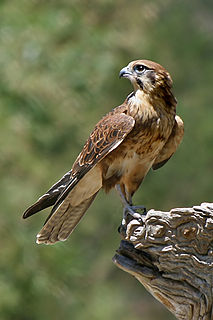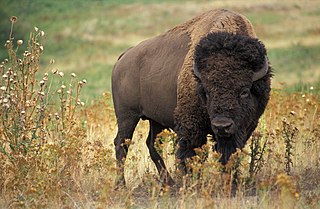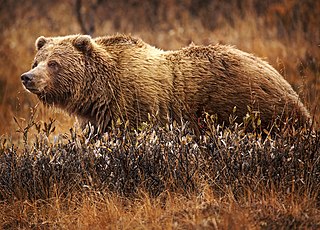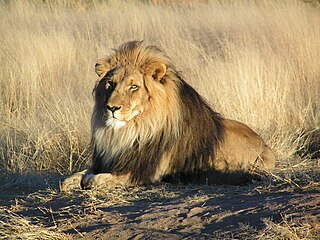The Transformers is a line of mecha toys produced by the Japanese company Takara and American toy company Hasbro. Initially a line of transforming mecha toys rebranded from Takara's Diaclone and Microman toylines, it spawned the Transformers media franchise.
Grimlock is the name of several fictional robot characters in the Transformers robot franchise. He is usually portrayed as the leader of the Dinobots, a subfaction of Autobots that can transform into dinosaurs. In 2007, USA Today polled people as to which Transformer they want to appear in the second installment in the Transformers film series; Grimlock came in tied for second with Devastator.

Beast Wars: Transformers, is an American-Canadian computer animated television series that debuted in 1996 and ended on March 7, 1999, serving as the flagship of the Transformers: Beast Wars franchise. The series featured the Maximals and Predacons, descendants of the Autobots and Decepticons respectively, and was set in the future of the "original" Transformers continuity; however, it was eventually revealed that they had traveled back in time before the series began and were actually on a prehistoric Earth some time in between when Optimus Prime and Megatron first crash-landed on Earth and the time when they awoke. Beast Wars was set up as a sequel to the first Transformers series.
Galvatron is a name adopted by several fictional characters in the Transformers robot superhero franchise. He is usually the recreated form of Megatron, the Decepticon leader; however, it has been used for separate and unrelated characters, most notably the main villain of the anime series Beast Wars II, and the character from the more recent IDW Publishing G1 series.
Soundwave is a fictional character appearing in the various Transformers continuities in the Transformers robot superhero franchise. His most well-known transformation is that of a microcassette recorder. Throughout most of his incarnations, he is an undyingly loyal lieutenant of the Decepticon leader Megatron. He is Megatron's eyes and ears and, in some interpretations, only speaks when mocking the Autobots.

Optimus Primal is a fictional character from the Transformers toyline, and the leader of the Maximal forces and the protagonist in the Beast Wars television series. He is sometimes called Optimal Optimus. The name Optimus Primal was given to Optimus Prime during the initial run of the Beast Wars toy line, before it was decided that Optimus Primal was a separate character.

Beast Machines: Transformers is an American-Canadian animated television series produced by Mainframe Entertainment as part of the Transformers franchise. Hasbro has the full distribution rights to the show as of 2011. It was a direct sequel to Beast Wars, taking place within the continuity of the original Transformers series.. The show ran for two seasons, airing on YTV and Fox Kids from 1999 to 2000. Of the Transformers animated series produced in North America, Beast Machines was the only one to have been completely conceptualized and outlined in advance, lending it a more serialized and linear storyline than the others. Prior to Transformers: Prime in 2010, Beast Machines was also the last, and second only entirely computer-animated Transformers series produced, along with its predecessor Beast Wars. The Beast Machines intro theme was "Phat Planet", by Leftfield. It is also the final installment in the Generation 1 cartoon era.
Dinobots are a type of character in the fictional Transformers Universe. The Dinobots group consists of several subgroups of robots, each of whose transformed mode is that of a dinosaur or similar prehistoric animal. Dinobots are referred to as Dinotrons in the Japanese version, and Dinobots in the Japanese dub of Transformers Animated. They were named among the top selling toys in 1985 by Playthings magazine.
Scorponok is the name shared by several fictional characters in the various Transformers universes. Characters with this name are usually Decepticons or Predacons that turn into robotic scorpions or have scorpion-shaped robot modes. Some versions of the character are also known as Megazarak or Black Zarak in Japan.
Jetfire is the name of several fictional characters from the Transformers franchise. He is almost always depicted as an Autobot with jet or space shuttle alternate mode.
BotCon, briefly known as "The Official Transformers Collectors' Convention", was an annual convention for Transformers fans and collectors. BotCon has been held annually since 1994. BotCon is a syllabic abbreviation for "Robot Convention" but also refers to "Autobot" and "Decepticon", the protagonist and antagonist robot factions in the many continuities in the Transformers franchise.
Sideswipe is a fictional robot superhero character in the Transformers franchise. Because of trademark restrictions, toys of the character are sometimes marketed as SideSwipe.
Cliffjumper is the name of several fictional robot superhero characters from the Transformers robot superhero franchise. His name is usually associated with an Autobot whose toys are often red repaints or remold of Bumblebee toys.
Rodimus Prime is a fictional robot superhero character from the Transformers franchise. He was formerly known as Hot Rod and in The Transformers: The Movie, he was reformatted into Rodimus Prime when he received the Autobot Matrix of Leadership and assumed the role of the movie's protagonist. Hasbro has used the names Autobot Hot Rod, and Rodimus as replacements for later characters, due to trademark issues with the name Hot Rod. His alternate mode varies between depictions, but usually possesses a red, yellow, and silver paint job.
Transformers Universe is the title of several comic book series based on the Transformers series by Hasbro. The first comic book was printed in 1986 by Marvel Comics as a character guide, while later series printed by 3H Enterprises contained fiction for the Transformers: Universe toy line.
Transformers: Beast Wars is an entertainment franchise from Hasbro, and it is part of the larger Transformers franchise. The fiction directly follows the Transformers: Generation 1 continuity established by the 1984 series and animated film. It ignores the continuity established by the Japanese Transformers series, though this franchise would have two exclusive Japanese series of its own. Previous to Beast Wars, Hasbro had attempted to relaunch the original toys and animation as Transformers: Generation 2. Hasbro intended another franchise titled Transtech to follow, combining Beast Wars and Generation 1 characters and aesthetics, but this was cancelled. Instead the franchise began a series of reboots, beginning with the Japanese-produced Transformers: Car Robot series, internationally known as Transformers: Robots in Disguise.

















